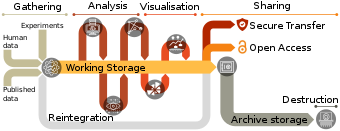Data management
Data management comprises all disciplines related to handling data as a valuable resource, it is the practice of managing an organization's data so it can be analyzed for decision making.[1]
Concept
The concept of data management arose in the 1980s as technology moved from sequential processing [2] (first punched cards, then magnetic tape) to random access storage.
Since it was now possible to store a discrete fact and quickly access it using random access disk technology, those suggesting that data management was more important than business process management used arguments such as "a customer's home address is stored in 75 (or some other large number) places in our computer systems."[citation needed] However, during this period, random access processing was not competitively fast, so those suggesting "process management" was more important than "data management" used batch processing time as their primary argument.
As application software evolved into real-time, interactive usage, it became obvious that both management processes were important. If the data was not well defined, the data would be mis-used in applications. If the process wasn't well defined, it was impossible to meet user needs.
Patterns
Followings are common data management patterns:[3]
- Cache-aside
- command query responsibility segregation (CQRS)
- Event sourcing
- Index table
- Materialized view
- Sharding
- Valet key
- Static content hosting
Topics
Topics in data management include:
- Data governance
- Data architecture
- Data modeling and design
- Database and storage management
- Data security
- Reference and master data
- Data integration and inter-operability
- Documents and content
- Data warehousing and business intelligence and analytics
- Metadata
- Data quality
Usage
| Part of a series on |
| Library and information science |
|---|
 |
In modern management usage, the term data is increasingly replaced by information or even knowledge in a non-technical context. Thus data management has become information management or knowledge management. This trend obscures the raw data processing and renders interpretation implicit. The distinction between data and derived value is illustrated by the information ladder. However, data has staged a comeback with the popularisation of the term big data, which refers to the collection and analyses of massive sets of data. While big data is a recent phenomenon, the requirement for data to aid decision-making traces back to the early 1970s with the emergence of decision support systems (DSS). These systems can be considered as the initial iteration of data management for decision support.[4]
Several organisations have established data management centers (DMC) for their operations.[5]
Data sources
Marketers and marketing organizations have been using data collection and analysis to refine their operations for the last few decades. Marketing departments in organizations and marketing companies conduct data collection and analysis by collecting data from different data sources and analyzing them to come up with insightful data they can use for strategic decision-making (Baier et al., 2012). In the modern business environment, data has evolved into a crucial asset for businesses since businesses use data as a strategic asset that is used regularly to create a competitive advantage and improve customer experiences. Among the most significant forms of data is customer information which is a critical asset used to assess customer behavior and trends and use it for developing new strategies for improving customer experience (Ahmed, 2004). However, data has to be of high quality to be used as a business asset for creating a competitive advantage. Therefore, data governance is a critical element of data collection and analysis since it determines the quality of data while integrity constraints guarantee the reliability of information collected from data sources. Various technologies including Big Data are used by businesses and organizations to allow users to search for specific information from raw data by grouping it based on the preferred criteria marketing departments in organizations could apply for developing targeted marketing strategies (Ahmed, 2004). As technology evolves, new forms of data are being introduced for analysis and classification purposes in marketing organizations and businesses. The introduction of new gadgets such as Smartphones and new-generation PCs has also introduced new data sources from which organizations can collect, analyze and classify data when developing marketing strategies. Retail businesses are the business category that uses customer data from smart devices and websites to understand how their current and targeted customers perceive their services before using the information to make improvements and increase customer satisfaction (Cerchiello and Guidici, 2012). Analyzing customer data is crucial for businesses since it allows marketing teams to understand customer behavior and trends which makes a considerable difference during the development of new marketing campaigns and strategies. Retailers who use customer data from various sources gain an advantage in the market since they can develop data-informed strategies for attracting and retaining customers in the overly competitive business environment. Based on the information on the benefits of data collection and analysis, the following hypotheses are proposed: The sources of data used as the foundation of data collection and analysis have a considerable impact on the data analysis tools used for analyzing and categorizing data.
Data analysis tools
Organizations use various data analysis tools for discovering unknown information and insights from huge databases; this allows organizations to discover new patterns that were not known to them or extract buried information before using it to come up with new patterns and relationships (Ahmed, 2004). There are 2 main categories of data analysis tools, data mining tools and data profiling tools. Also, most commercial data analysis tools are used by organizations for extracting, transforming and loading ETL for data warehouses in a manner that ensures no element is left out during the process (Turban et al., 2008). Thus the data analysis tools are used for supporting the 3 Vs in Big Data: volume, variety and velocity. Factor velocity emerged in the 1980s as one of the most important procedures in data analysis tools which was widely used by organizations for market research. The tools used to select core variables from the data that was collected from various sources and analyzed it; if the amount of data used to be too huge for humans to understand via manual observation, factor analysis would be introduced to distinguish between qualitative and quantitative data (Stewart, 1981). Organizations collect data from numerous sources including websites, emails and customer devices before conducting data analysis. Collecting data from numerous sources and analyzing it using different data analysis tools has its advantages, including overcoming the risk of method bias; using data from different sources and analyzing it using multiple analysis methods guarantees businesses and organizations robust and reliable findings they can use in decision making. On the other hand, researchers use modern technologies to analyze and group data collected from respondents in the form of images, audio and video files by applying algorithms and other analysis software Berry et al., 1997). Researchers and marketers can then use the information obtained from the new generation analysis tools and methods for forecasting, decision support and making estimations for decision making. For instance, information from different data sources on demand forecasts can help a retail business determine the amount of stock required in an upcoming season depending on data from previous seasons. The analysis can allow organizations to make data-informed decisions to gain competitive advantage in an era where all businesses and organizations are capitalizing on emerging technologies and business intelligence tools to gain competitive edges. While there are numerous analysis tools in the market, Big Data analytics is the most common and advanced technology that has led to the following hypothesis: Data analytic tools used to analyze data collected from numerous data sources determine the quality and reliability of data analysis.
Data security and data privacy
While organizations need to use quality data collection and analysis tools to guarantee the quality and reliability of the customer data they collect, they must implement security and privacy strategies to protect the data and customer information from privacy leaks (Van Till, 2013). A study conducted by PWC indicated that more than two-thirds of retail customers prefer purchasing products and services from businesses that have data protection and privacy plans for protecting customer information. Also, the study indicated that customers trust businesses that can prove they cannot use customer data for any other purposes other than marketing. As technology and the Internet continue improving, the success of businesses using it as a platform for marketing their products will depend on how effectively they can gain and maintain the trust of customers and users. Therefore, businesses will have to introduce and implement effective data protection and privacy strategies to protect business data and customer privacy. Although developing trust between customers and businesses affects the customers’ purchasing intentions, it also has a considerable impact on long-term purchasing behaviors including how frequently customers purchase which could impact the profitability of a business in the long run. Thus, the above information leads to the following hypothesis: Implementing data security and privacy plans has a positive impact on economic and financial outcomes.
Financial and economic outcomes
Studies indicate that customer transactions account for a 40% increase in the data collected annually, which means that financial data has a considerable impact on business decisions. Therefore, modern organizations are using big data analytics to identify 5 to 10 new data sources that can help them collect and analyze data for improved decision-making. Jonsen (2013) explains that organizations using average analytics technologies are 20% more likely to gain higher returns compared to their competitors who have not introduced any analytics capabilities in their operations. Also, IRI reported that the retail industry could experience an increase of more than $10 billion each year resulting from the implementation of modern analytics technologies. Therefore, the following hypothesis can be proposed: Economic and financial outcomes can impact how organizations use data analytics tools.
See also
- Open data
- FAIR data
- Pseudonymization
- Information architecture
- Enterprise architecture
- Information design
- Information system
- Controlled vocabulary
- Data curation
- Data retention
- Data Management Association
- Data management plan
- Data mesh, a domain-oriented data architecture[6]
- Computer data storage
- Data proliferation
- Digital preservation
- Document management
- Enterprise content management
- Hierarchical storage management
- Information repository
- Machine-readable document
- Performance report
- System integration
- Customer data integration
- Identity management
- Identity theft
- Data theft
- ERP software
- CRM software
References
- ^ "What Is Data Management? Importance & Challenges | Tableau". www.tableau.com. Retrieved 2023-12-04.
- ^ Hoare, C. A. R. (2004) [1985]. Communicating Sequential Processes. Prentice Hall International. ISBN 978-0-13-153271-7.
- ^ Mastering Cloud-Native Microservices Designing and implementing Cloud-Native Microservices for Next-Gen Apps. 2023. ISBN 9789355518699.
- ^ Watson, Hugh J.; Marjanovic, Olivera (2013). "Big Data: The Fourth Data Management Generation". Business Intelligence Journal; Seattle. 18 (3): 4–8.
- ^
For example: Kumar, Sangeeth; Ramesh, Maneesha Vinodini (2010). "Lightweight Management framework (LMF) for a Heterogeneous Wireless Network for Landslide Detection". In Meghanathan, Natarajan; Boumerdassi, Selma; Chaki, Nabendu; Nagamalai, Dhinaharan (eds.). Recent Trends in Networks and Communications: International Conferences, NeCoM 2010, WiMoN 2010, WeST 2010,Chennai, India, July 23-25, 2010. Proceedings. Communications in Computer and Information Science. Vol. 90. Springer. p. 466. ISBN 9783642144936. Retrieved 2016-06-16.
4.4 Data Management Center (DMC)[:] The Data Management Center is the data center for all of the deployed cluster networks. Through the DMC, the LMF allows the user to list the services in any cluster member belonging to any cluster [...].
- ^ "Data Mesh: Delivering data-driven value at scale".
External links
 Media related to Data management at Wikimedia Commons
Media related to Data management at Wikimedia Commons


